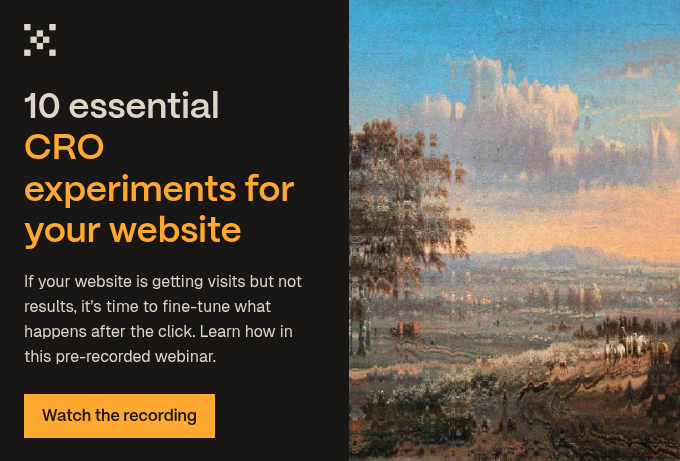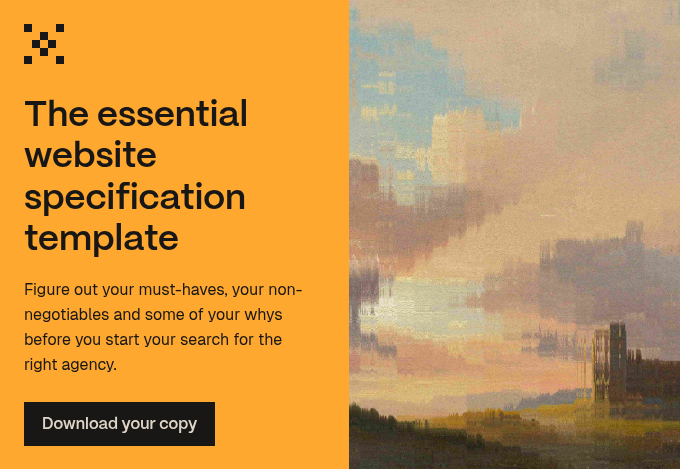Conversion rate optimisation (CRO) can feel like one of marketing’s dark arts. Businesses often pour money into driving traffic, only to see customers leave without acting. CRO makes sure that the investment actually pays off.
We’re glad the bad old days of ‘make the button green' and 'put everything in ALL CAPS’ are largely behind us. But too often CRO is still reduced to hunches and isolated tweaks. In reality, great CRO is methodical, evidence-driven and rooted in business outcomes.
That’s why our approach focuses on changes that measurably improve lead generation, form submissions, and user experience for the long term.
Here’s how we make that happen.
What CRO means to us
CRO is a mindset as much as it is a process. It’s not about chasing quick wins or obsessing over tiny, isolated metrics. It’s about aligning every element of your website with the real-world outcomes your business needs.
Data before decisions
Every change starts with evidence. We dig into analytics, heatmaps, user journey data, and even session recordings to understand what’s really happening on your site. Are users hesitating before clicking the “Request a demo” button? Are they abandoning forms halfway through? Is your highest-traffic blog post a dead end instead of a lead generator? These insights shape our hypotheses and give us a strong starting point for every intervention.
Business-aligned outcomes
A prettier form or a bolder button is meaningless unless it drives the right kind of results. We measure CRO success in tangible, business-focused metrics: qualified leads, booked demos, newsletter subscribers who actually engage, and sales conversations that turn into revenue. Everything we do is tied back to a number your leadership team will care about.
User-first improvements
CRO ‘improvements’ that ultimately annoy your audience are self-defeating. Pop-ups that block content, forms that ask for too much too soon, or unclear next steps all erode trust. Our changes are designed to remove friction and guide visitors through your site in a way that feels natural, intuitive and respectful of their time. If a change doesn’t make your user’s life easier, it doesn’t make the list.
Ongoing refinement
High-value CRO isn’t a “set it and forget it” activity. User behaviour evolves, markets shift and competitors change the game. That’s why our work is iterative. We test, learn, and build on successes. A small tweak that boosts conversions by 5% might not sound dramatic on its own, but layer enough of those gains together over months and you’ve transformed the performance of your site.
Our four golden rules of CRO
Like tuning a finely-made watch, CRO requires precision and care. We follow these rules on every project:
- Do no harm. Every change is tested or reviewed before going live. If there’s even a small chance it will hurt conversions or user experience, it’s out.
- Prioritise measurable impact. We set clear metrics for each intervention. Whether that’s a percentage increase in form completions, more CTA clicks or a higher number of qualified leads.
- Document everything. Clients should be able to see exactly what we changed and why. We capture before/after data, screenshots and commentary so nothing gets lost.
- Ask, don’t guess. If something’s unclear, we dig into our internal knowledge base, research it or call on our colleagues. We never wing it.
Tools we use for CRO
We combine proven platforms with our own processes:
- Heatmaps and session recordings. To pinpoint where users hesitate, click or drop off.
- Google Analytics 4. To track conversions, funnels, and user journeys.
- HubSpot. To monitor form performance, test CTAs, and track lead sources.
- A/B testing software. For structured experiments on layouts, copy, and design elements.
- Internal CRO playbook. Our tested library of interventions for forms, CTAs, lead magnets, and page structures.
How we plan and deliver CRO work
Step 1. Identify opportunities
Before we touch a single pixel, we go into detective mode. CRO is all about finding the invisible roadblocks between a visitor landing on your site and them taking action, and sometimes those roadblocks are hiding in plain sight.
We start with the data. Analytics tells us what is happening: where users land, where they drop off, which CTAs they ignore, and which ones get clicked. Heatmaps and session recordings tell us how they interact with the page - are they scrolling past your main offer, hovering over an image that doesn’t link anywhere, or clicking on something that looks like a button but isn’t?
From there, we layer on our own experience. We’ve seen enough underperforming “Request a demo” pages to know the usual suspects, such as too many form fields, unclear value propositions, or the dreaded “We’ll get back to you soon” message.
For each potential change, we define:
- A hypothesis, for example “We believe simplifying this form from eight fields to four will increase completions by at least 15%, because shorter forms lower friction and feel less daunting.”
- Metrics, which are the numbers that will tell us if we were right, like form completion rate, lead quality, or average time on page.
- Resources, such as identifying ****who’s doing the work, what tools we need, and whether we’ll need design or dev support.
Typical opportunities include:
- Interactive lead magnets such as quizzes, calculators, or downloadable guides that attract high-intent users.
- Form optimisation for shorter, smarter forms, embedded booking widgets, and autofill to remove friction.
- Page structure improvements such as moving key proof points and CTAs above the fold so they’re impossible to miss.
- Social proof such as the inclusion of testimonials, client logos, or case study snapshots to build trust.
- Content gating for transforming high-traffic blog posts and whitepapers into lead capture opportunities.
- Pop-ups and banners strategically timed to appear when they’re helpful, not when they’re annoying.
Step 2. Make the changes
We start with the changes that are most likely to make a significant impact and work our way down the priority list.
Sometimes that means a high-stakes update, like introducing an interactive quiz that hooks visitors and captures their details in one go. Other times, it’s deceptively simple, for example, changing a vague ‘Submit’ button to a benefit-led “Get my free guide” or replacing a wall of text with a concise value proposition.
We test every update before it’s pushed live. That means checking functionality, making sure the design still looks great on mobile, and confirming it aligns with the rest of the user journey.
Step 3. Show the proof
The thing about CRO is that a lot of the wins are subtle. A form might look almost the same, but suddenly it’s converting twice as many visitors. A button might be moved by just a few centimetres on the page, but clicks have jumped.
That’s why we document every change as we make it. Proof of execution isn’t just for agency/client transparency. It’s also an ongoing record we can learn from. If something works, we want to know why so we can replicate it elsewhere. If it doesn’t, we want to understand that too.
We capture:
- Before/after metrics such as “Newsletter sign-ups increased 2.3x” or “400+ extra leads over six months.”
- Screenshots so clients can see exactly what changed.
- Notes and insights which explain why a change worked, what user behaviour we observed, and recommendations for the next round of optimisation.
This way, our clients don’t just see the what. They also see the why, which makes every result more valuable.
Typical results clients see
Recent CRO projects have delivered:
- Over 400 incremental leads in six months.
- 2.3x more newsletter sign-ups.
- Hundreds of extra monthly clicks on high-value CTAs.
- Higher “hot lead” form submissions that sales teams noticed immediately.
Ready to improve your website performance?
If your website is getting traffic but not enough conversions, we’ll help you find the hidden friction points and turn them into opportunities for growth.

 Posted by
Sam Beddall
Posted by
Sam Beddall
.jpg?width=1600&height=800&name=Frame%201584%20(1).jpg)



.jpg?width=400&height=250&name=art-institute-of-chicago-pybByTGQ9zI-unsplash%201%20(1).jpg)

